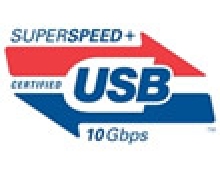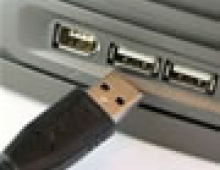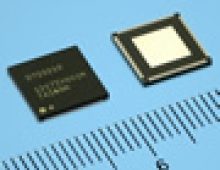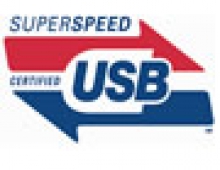
4.8Gbps USB 3.0 Specification Now Available
The USB 3.0 Promoter Group announced the completion of the USB 3.0 specification, the technical map for device manufacturers to deliver SuperSpeed USB technology to the market.
SuperSpeed USB brings significant power and performance enhancements to the popular USB standard while offering backward compatibility with USB-enabled PCs and peripheral devices currently in use. SuperSpeed USB delivers data transfer rates up to ten times faster than Hi-Speed USB (USB 2.0) with optimized power efficiency.
"SuperSpeed USB is the next advancement in ubiquitous technology," said Jeff Ravencraft, USB-IF president and chairman. "Today?s consumers are using rich media and large digital files that need to be easily and quickly transferred from PCs to devices and vice versa. SuperSpeed USB meets the needs of everyone from the tech-savvy executive to the average home user."
Super-Speed USB 3.0 offers a transfer rate of 4.8Gbps and it will join High-Speed (USB 2.0, 480Mbps), Full Speed, (USB 1.0, 12Mbitps) and Low Speed (USB 1.0, 1.5Mbps) on the list USB standards. On the other hand, a new version of the FireWire stanrdard - S3200 and S1600 - was published last August. The so-called "Standard for High Performance Serial Bus," " offers speeds of 1.6 Gigabit/second and 3.2 Gigabit/second. Devices, however, aren't expected until the end of next year/beginning of 2010.
The USB 3.0 Promoter Group, comprised of Hewlett-Packard Company, Intel Corporation, Microsoft Corporation, NEC Corporation, ST-NXP Wireless and Texas Instruments, developed the USB 3.0 specification. The group now has transitioned the specification?s management to the USB Implementers Forum (USB-IF), the managing body of USB specifications. The USB 3.0 Promoter Group is now accepting adopters of the USB 3.0 specification, which has been finalized at the 1.0 level. To download both the specification and adopter agreement, visit http://www.usb.org/developers/docs/.
It is anticipated that initial SuperSpeed USB discrete controllers will appear in the second half of 2009 and consumer products will appear in 2010, with adoption continuing throughout 2010. The first SuperSpeed USB devices will likely include data-storage devices such as flash drives, external hard drives, digital music players and digital cameras.
The USB 3.0 specification debuted on Monday in conjunction with the first SuperSpeed USB Developers Conference in San Jose, California.
"SuperSpeed USB is the next advancement in ubiquitous technology," said Jeff Ravencraft, USB-IF president and chairman. "Today?s consumers are using rich media and large digital files that need to be easily and quickly transferred from PCs to devices and vice versa. SuperSpeed USB meets the needs of everyone from the tech-savvy executive to the average home user."
Super-Speed USB 3.0 offers a transfer rate of 4.8Gbps and it will join High-Speed (USB 2.0, 480Mbps), Full Speed, (USB 1.0, 12Mbitps) and Low Speed (USB 1.0, 1.5Mbps) on the list USB standards. On the other hand, a new version of the FireWire stanrdard - S3200 and S1600 - was published last August. The so-called "Standard for High Performance Serial Bus," " offers speeds of 1.6 Gigabit/second and 3.2 Gigabit/second. Devices, however, aren't expected until the end of next year/beginning of 2010.
The USB 3.0 Promoter Group, comprised of Hewlett-Packard Company, Intel Corporation, Microsoft Corporation, NEC Corporation, ST-NXP Wireless and Texas Instruments, developed the USB 3.0 specification. The group now has transitioned the specification?s management to the USB Implementers Forum (USB-IF), the managing body of USB specifications. The USB 3.0 Promoter Group is now accepting adopters of the USB 3.0 specification, which has been finalized at the 1.0 level. To download both the specification and adopter agreement, visit http://www.usb.org/developers/docs/.
It is anticipated that initial SuperSpeed USB discrete controllers will appear in the second half of 2009 and consumer products will appear in 2010, with adoption continuing throughout 2010. The first SuperSpeed USB devices will likely include data-storage devices such as flash drives, external hard drives, digital music players and digital cameras.
The USB 3.0 specification debuted on Monday in conjunction with the first SuperSpeed USB Developers Conference in San Jose, California.




















